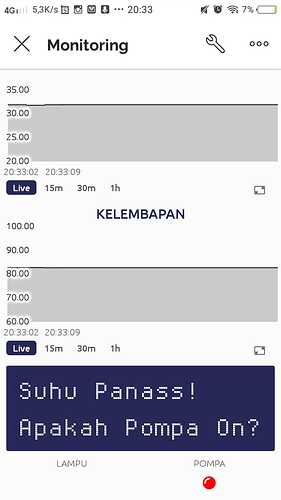This is re-reading the pin, instead of using a global variable to store the current status of the relay - which would be updated only when you changed the status through a digitalWrite.
We’ve both explained this approach multiple times, but you don’t seem to be able to grasp the concept.
Pete.
1 Like
i see, u mean use this ? Sry guys i will learn harder
Blynk_Coeur:
if (t <= MinTemperature) {
digitalWrite(RELAY_PIN_1, LOW); //Turn on Relay 1
digitalWrite(RELAY_PIN_2, HIGH);
lcd2.clear(); //Use it to clear the LCD Widget
lcd2.print(0, 0, "Suhu Dinginn"); //Sending " Cold Temperature" To Blynk
lcd2.print(0, 1, "Apakah Lampu On?"); //Sending " Hot Temperature" To Blynk
led1.on();
led2.off();
}
The update :
#include <LiquidCrystal_I2C.h>
#include <Wire.h>
#include <DHT.h>
#define BLYNK_PRINT Serial
#define BLYNK_AUTH_TOKEN "------------------------------------------"
#include <BlynkSimpleEsp32.h>
#include <WiFi.h>
#include <WiFiClient.h>
#include <DHT.h>
LiquidCrystal_I2C lcd(0x27, 16, 2);
#define DHTPIN 4 // What digital pin we're connected to
#define DHTTYPE DHT22 // DHT 22, AM2302, AM2321
DHT dht(DHTPIN, DHTTYPE);
WidgetLCD lcd2(V9); //Blynk LCD
WidgetLED led1(V2); //LED for Relay 1
WidgetLED led2(V3); //LED for Relay 2
float h ;
float t ; // or dht.readTemperature(true) for Fahrenheit
const int RELAY_PIN_1 = 14; //Lampu Halogen/Halogen Lamp
const int RELAY_PIN_2 = 13; //Pompa Air/Water Pump
//SDA pin on I2C module to pin D21 on ESP32
//SCL pin on I2C module to pin D22 on ESP32
const float MinTemperature = 25.0;
const float MaxTemperature = 28.0;
BlynkTimer timer;
char ssid[] = "TexasKost";// Your WiFi credentials.
char pass[] = "eviudahpwt";// Set password to "" for open networks.
void sendSensor()
{
h = dht.readHumidity();
t = dht.readTemperature(); // or dht.readTemperature(true) for Fahrenheit
if (isnan(h) || isnan(t)) {
lcd2.clear();
lcd2.print(0, 0, "Gagal membaca sensor");// Sending to LCD Blynk "Failed to read data from sensor"
return;
}
// You can send any value at any time.
// Please don't send more that 10 values per second.
Blynk.virtualWrite(V5, h);
Blynk.virtualWrite(V6, t);
lcd.setCursor(0, 0); //menentukan posisi kursor pada LCD
lcd.print("H : ");
lcd.print(h);
lcd.print("%");
lcd.setCursor(0, 1);
lcd.print("T : ");
lcd.print(t);
lcd.print("C");
if (t <= MinTemperature) {
digitalWrite(RELAY_PIN_1, LOW); //Turn on Relay 1
digitalWrite(RELAY_PIN_2, HIGH);
lcd2.clear(); //Use it to clear the LCD Widget
lcd2.print(0, 0, "Suhu Dinginn!"); //Sending " Cold Temperature" To Blynk
lcd2.print(0, 1, "Apakah Lampu On?"); //Sending " Is it Lamp On?" To Blynk
led1.on();
led2.off();
}
else if (t >= MaxTemperature) {
digitalWrite(RELAY_PIN_1, HIGH);
digitalWrite(RELAY_PIN_2, LOW);//Turn on Relay 2
lcd2.clear();
lcd2.print(0, 0, "Suhu Panass!"); //Sending " Hot Temperature" To Blynk
lcd2.print(0, 1, "Apakah Pompa On?"); //Sending " Is it Pump on?" To Blynk
led1.off();
led2.on();
}
}
void setup()
{
// Debug console
Serial.begin(115200);
lcd.begin();
lcd.backlight();
Blynk.begin(BLYNK_AUTH_TOKEN, ssid, pass);
dht.begin();
pinMode(RELAY_PIN_1, OUTPUT);
pinMode(RELAY_PIN_2, OUTPUT);
// Setup a function to be called every second
timer.setInterval(1000L, sendSensor);
}
void loop()
{
timer.run();
Blynk.run();
}
